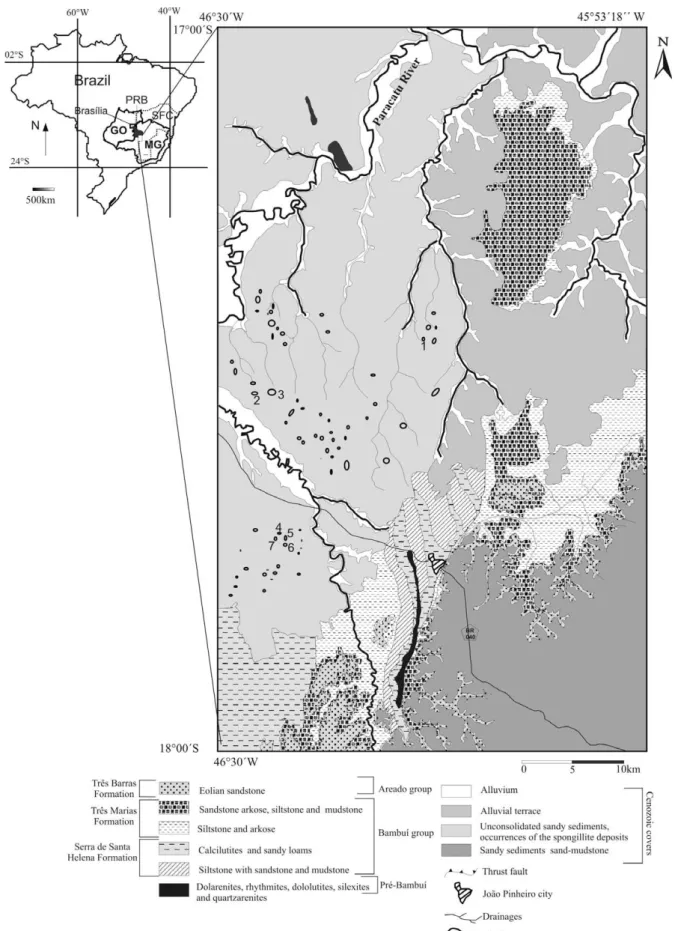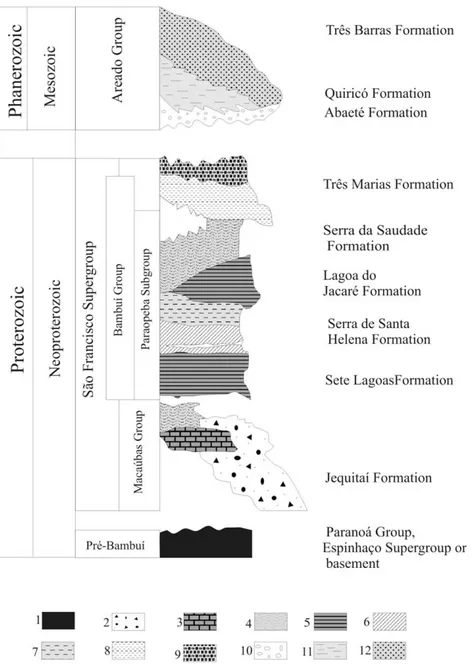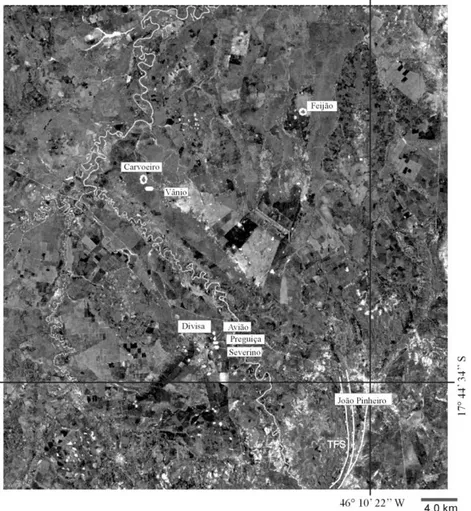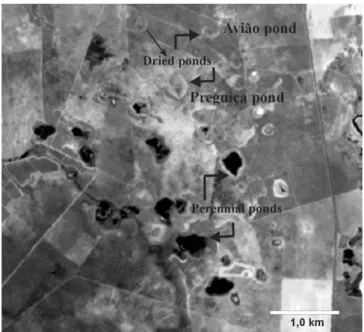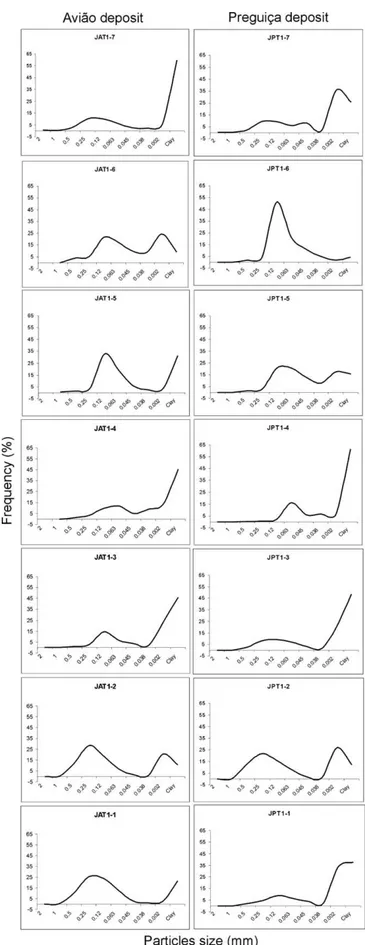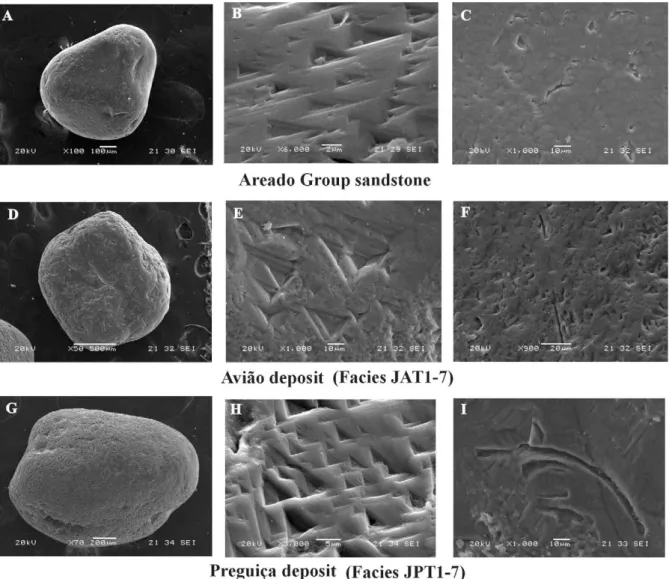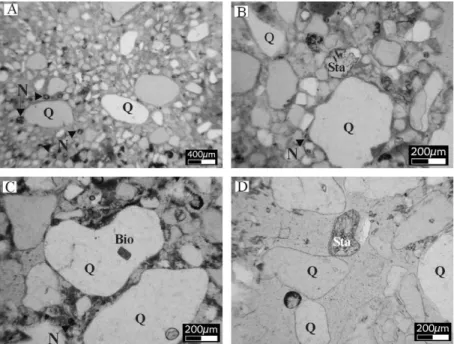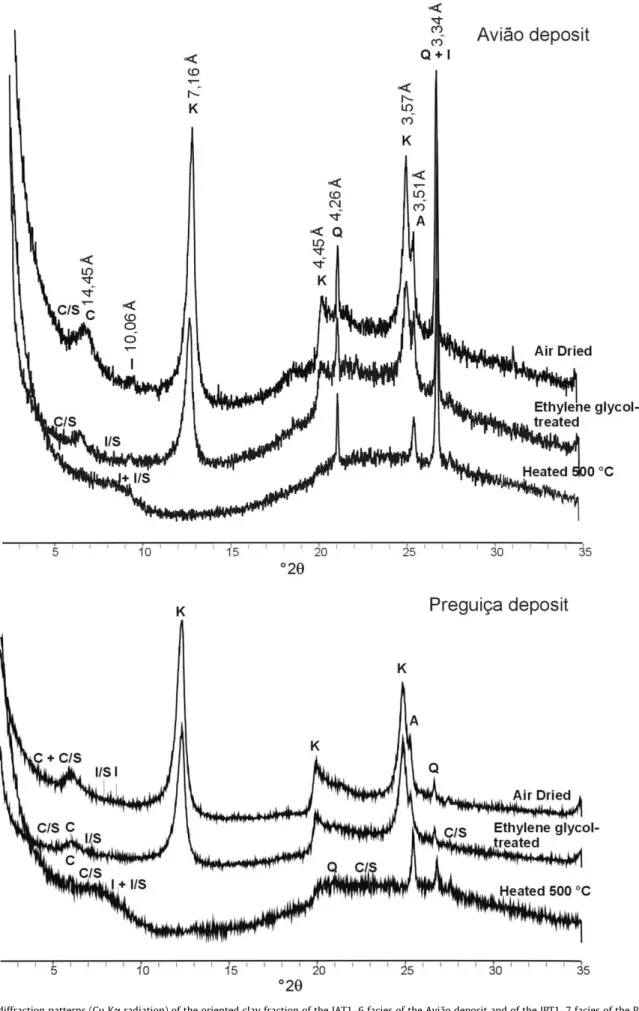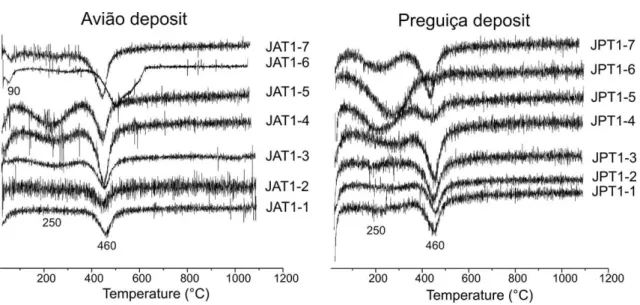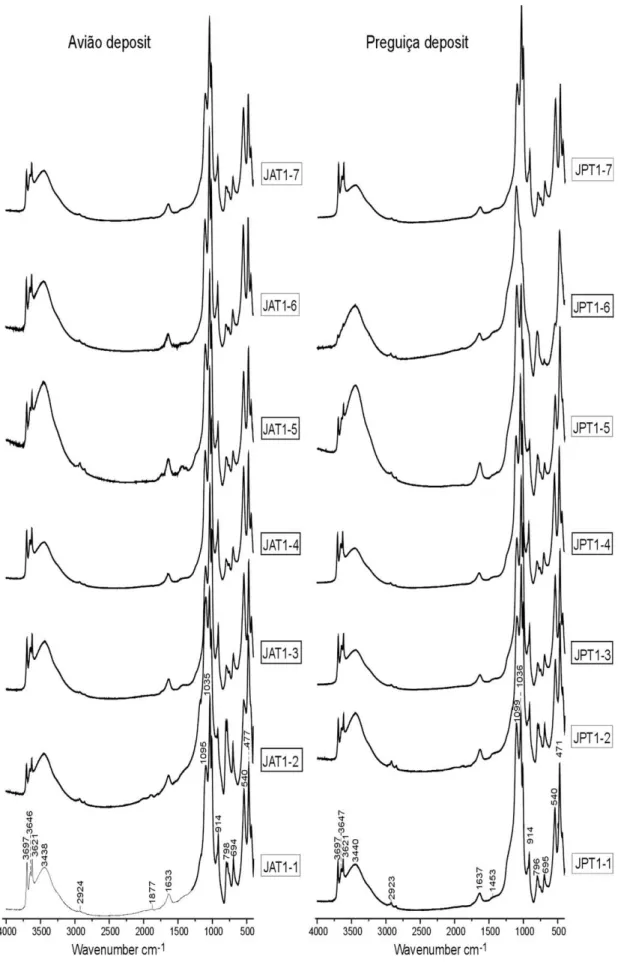Characterization and origin of spongillite-hosting sediment from João Pinheiro,
Minas Gerais, Brazil
A.C.S. Almeida
a, A.F.D.C. Varajão
a,*, N.S. Gomes
a, C.A.C. Varajão
a, C. Volkmer-Ribeiro
b aGeology Department, School of Mines, Federal University of Ouro Preto, Morro do Cruzeiro, 35400-000 Ouro Preto, MG, BrazilbMuseum of Natural Sciences, Zoobotanical Foundation of Rio Grande do Sul, Mail Box 1188, 90001-970 Porto Alegre, RS, Brazil
a r t i c l e
i n f o
Article history:
Received 31 October 2008 Accepted 18 September 2009
Keywords:
Spongillite Aeolian quartz Heavy minerals Staurolite Areado Group
São Francisco Supergroup
a b s t r a c t
Spongillite from João Pinheiro, Minas Gerais, Brazil is mainly known for its use in brick production and in the refractory industry. Very few studies have focused on its geological context. Spongillite-rich deposits occur in shallow ponds on a karstic planation surface developed on rocks of the Neoproterozoic São Fran-cisco Supergroup. Cenozoic siliciclastic sediments are related to this surface. A field study of these depos-its and analysis of multispectral images showed a SE–NW preferential drainage system at SE, suggesting that Mesozoic Areado Group sandstones were the source area of the spongillite-hosting sediments. Min-eralogical and textural characterization by optical microscopic analysis, X-ray diffraction (XRD), differen-tial and gravimetric thermal analysis (DTA-GTA), infrared spectroscopy (IR) and scanning electron microscopy (SEM) of seven open-pit spongillite-rich deposits (Avião, Carvoeiro, Vânio, Preguiça, Divisa, Severino, Feijão) showed a sedimentological similarity between the deposits. They are lens-shaped and are characterized at the bottom by sand facies, in the middle by spicules-rich muddy-sand facies and at the top by organic matter-rich muddy-sand facies.
Petrographically, the spongillite-hosting sediments and the siliclastic sediments of the Areado Group show detrital phases with similar mineralogical and textural features, such as the presence of well-sorted quartz grains and surface features of abrasion typical of aeolian reworking that occurred in the deposi-tional environment in which the sandstones of the Areado Group were formed. Detrital heavy minerals, such as staurolite, zircon, tourmaline, and clay minerals, such as kaolinite, low amounts of illite, scarce chlorite and mixed-layer chlorite/smectite and illite/smectite occur in the spongillite-hosting sediments and in sandstones from the Areado Group. In both formations, staurolite has similar chemical composi-tion. These mineralogical and textural features show that the sediments of the Areado Group constitute the main source of the pond sediments that host spongillite.
Ó2009 Elsevier Ltd. All rights reserved.
1. Introduction
Most of the sedimentary rocks composed mainly of siliceous sponge spicules are formed in a marine environment and are called spiculites (Tasch, 1973). They may also form in particular conti-nental conditions, such as lakes and ponds (Harrison et al., 1979; Hall and Herrmann, 1980; Harrison, 1988; Sifeddine et al., 1994; Volkmer-Ribeiro and Turcq, 1996; Cordeiro et al., 1997; Turcq et al., 1998; Cândido et al., 2000; Gaiser et al., 2004) and are then called spongillites. Spongillites are essentially formed of siliceous sponge spicules of the Demospongiae Class, associated with clay, sand, organic matter and diatom residues.
In Brazil, two main areas of spongillite formations have been re-ported (Volkmer-Ribeiro and Motta, 1995): a large inner region in southwest Brazil and an outer region along the northeastern ocean
border from Maranhão to Rio Grande do Norte. The southwestern region encompasses western and southwestern Minas Gerais, southern Goiás, northeastern Mato Grosso do Sul and northern São Paulo.
Particularly, in the western part of Minas Gerais, in the João Pin-heiro region, the focus of this research, more than 80 lacustrine deposits that are rich in sponge spicules occur, presenting an
in situ reserve on the order of 5.8 million tons. The lens-shaped
spongillite-rich deposits were deposited in shallow depressions that often became lakes (ponds) during the rainy seasons. The thickness of the deposits varies from 2.5 m to around 5 m, and the average diameter of ponds is about 130 m. They contain differ-ent layers of nearly pure spongillite intercalated with layers of san-dy, silty and clayey sediments with a variable proportion of sponge spicules.
Numerous Brazilian research papers have dealt with bio-sili-ceous deposits; however, they have been related mostly to taxon-omy with palaeoenvironmental implications (Traxler, 1895; Abreu,
0895-9811/$ - see front matterÓ2009 Elsevier Ltd. All rights reserved.
doi:10.1016/j.jsames.2009.09.006
* Corresponding author. Tel.: +55 31 35591876; fax: +55 31 3559 1606.
E-mail address:angelica@degeo.ufop.br(A.F.D.C. Varajão).
Contents lists available atScienceDirect
Journal of South American Earth Sciences
1973; Volkmer-Ribeiro, 1981, 1999; Cordeiro et al., 1997; Cândido et al., 2000; Sifeddine et al., 1994; Volkmer-Ribeiro and Motta, 1995; Volkmer-Ribeiro and Turcq, 1996; Volkmer-Ribeiro et al., 1998a,b, 2001; Melão and Rocha, 1999; Parolin et al., 2007, 2008; Almeida et al., 2009), rather than to their technical characterization (Esper, 2000; Yamamoto, 2000; Almeida et al., 2008), which con-cern applications such as ceramics, refractory products, chromato-graphic supplies and catalysis matrices (Souza et al., 1988; Delbem et al., 2001; Santos et al., 2002; Teixeira, 2002), among others. There is no record of research focusing on the petrological charac-terization of the hosting sediments of the spongillites, which is of fundamental importance to the understanding of their environ-mental conditions of formation.
Seven spongillite-rich deposits (Avião, Carvoeiro, Vânio, Preg-uiça, Divisa, Severino, Feijão) located in the João Pinheiro region (Fig. 1) were characterized texturally and mineralogically based on representative profiles of the deposits where lateral and vertical
distribution of the different facies were defined as well as their possible relationships.
2. Study area and geological setting
The study area is located on the western portion of the São Fran-cisco craton, central Brazil (Fig. 1). It includes the Neoproterozoic São Francisco Supergroup, the Mesozoic Areado Group and the Cenozoic siliciclastic sediments associated with karstic planation surfaces where the spongillite-rich deposits occur (Figs. 1 and 2).
The lowermost stratigraphic unit found in the study area was established byOliveira et al. (2002), but lacks a well-defined strati-graphic relationship with the adjacent units. This basal unit is com-posed of dolarenites, rhythmites, dololutites, silexites and quartzarenites, deposited in a shallow and transitional marine environment. According toOliveira et al. (2002), this unit may be
correlated to the Sete Lagoas Formation in a more distal situation within the basin or to the Paranoá Group (Fig. 2).
The São Francisco Supergroup covers a large part of the southern segment of the craton (Fig. 1), forming the São Francisco Basin. It comprises the Macaúbas and Bambuí groups (Fig. 2), which extend to the states of Goiás, Bahia and Minas Gerais. These units are genet-ically very distinct and overlie granite and gneiss of the basement and metasedimentary rocks of the Paranoá Group and Espinhaço Supergroup. The Macaúbas Group (Pflug and Renger, 1973), repre-sented by the Jequitai Formation (Dardenne, 1978), comprises dia-mictites, sandstones and, secondarily, pelites. The Bambuí Group, which is formed of intercalated marine limestones and siliciclastic units, comprises two sequences (Fig. 2): (i) the Paraopeba Subgroup (Sete Lagoas, Serra de Santa Helena, Lagoa do Jacaré and Serra da Saudade formations) and (ii) the Três Marias Formation.
The Mesozoic Areado Group (Rimann, 1917; Barbosa, 1965; Costa and Grossi Sad, 1968; Ladeira and Brito, 1968; Hasui and Penalva, 1970) is the unit of the São Francisco Basin with the great-est lateral variation of lithofacies. The lateral changes resulted from the simultaneous interaction of several environmental conditions, amongst which anastomosed alluvial/fluvial fans, fluvio-deltaic, lacustrine and dunes/interdune conditions are prominent. It com-prises three strongly interfingered formations (Fig. 2): (i) Abaeté Formation (Barbosa et al., 1970; Ladeira et al., 1971) formed of polymictic conglomerates, (ii) Quiricó Formation (Seer et al., 1989; Sgarbi, 1989), consisting predominantly of pelitic sediments, and (iii) Três Barras Formation (Ladeira and Brito, 1968; Cardoso, 1971; Sgarbi, 1989, 1991), comprising aeolian, fluvial and fluvio-deltaic sandstones. According toSgarbi (1989), in the western
por-tion of Minas Gerais, the aeolian condipor-tions predominate over the fluvial and fluvio-deltaic conditions. This statement is corroborated by the stratigraphic analysis of the Upper Jurassic–Lower Creta-ceous of the southern São Francisco Basin (Kattah, 1991; Sgarbi, 2000) that shows microscopic features of bimodality of the quartz grains typical of aeolian conditions.
In the study area (Fig. 1), Neogene/Holocene elluvial-colluvial covers prevail, composed mainly of unconsolidated clayey–sandy sediments. They form a characteristic flat landscape, corresponding to a surface of erosion in a karstic environment, with lakes where siliceous spicules, originated from freshwater sponge skeletons, were deposited, forming spongillite-rich deposits. According to
Oliveira et al. (2002), these Cenozoic sediments have as a substrate the Bambuí Group (Serra de Santa Helena and Três Marias forma-tions) and the Pre-Bambuí unit, and laterally, the rocks of the Mesozoic Areado Group (Três Barras Formation).
3. Materials and methods
Digital LANDSAT TM7 images, processed with ERMapper 6.4 program (color composition, main components, IHS), were used in order to define the deposits and their relationship with the adja-cent units. The results were subsequently superimposed on a dig-ital terrain model (SRTM).
Field studies involved the description of representative profiles of the spongillite-rich deposits with respective discriminated and sampled facies. Seven deposits (Avião, Carvoeiro, Vânio, Preguiça, Divisa, Severino, Feijão) were sampled, amounting to 49 deformed and non-deformed samples for textural, mineralogical and
logical characterization. In addition, six rock samples from the Are-ado Group were collected for the petrological study.
Textural characterization consisted of grain size analysis,
according to theEMBRAPA (1997)methodology based on humid
sieving of representative samples of the different facies from the pond deposits. The selected intervals were those of theWentworth (1922)scale, including sand (2, 1, 0.5, 0.25 and 0.063 mm) and silt fractions (0.045 and 0.038 mm). The clay fraction (<2
lm) was
sep-arated in suspension using a standard sedimentation procedure. The different fractions were dried at 40°C, weighed and separatedfor the subsequent mineralogical and morphological analyses. Mineralogical analysis by X-ray diffraction (XRD) used a Rigaku
GEIGERFLEXÒD/MAX-2B diffractometer with monochromated Cu
Karadiation with an angular range from 2°to 70°2h, a speed of 1.2°2hmin 1and a step size of 0.02 for the bulk sample, and an angular range from 2°to 35°2hand 0.6°2hmin 1for the oriented clay fraction (<2
lm). The clay fraction was previously saturated
with Ca++, and XRD analyses were performed on oriented prepara-tions previously air-dried, saturated with ethylene glycol and heated at 500°C for 5 h. The amorphous phases were determinedusing a PhilipsÒPW1730/10 diffractometer on randomly oriented samples with an angular range of 4°–36° 2h, a speed of 1.2°
2hmin 1and a step size of 0.02.
Differential thermal and thermogravimetric analyses (DTA-TGA) were carried out between 25 and 1100°C under a nitrogen
atmo-sphere with a SDT 2960 apparatus (TA Instruments) and at a heat-ing rate of 20°C min 1with calcinated alumina as the reference
material. Infrared spectroscopy (IR, BruckerÒ IFS 55) was carried out on all bulk samples, using both drift and transmission modes.
Optical microscopic investigations were carried out on thin sec-tions of undisturbed samples from the different facies and from the rocks of the underlying units. The petrographic study was comple-mented by scanning electron microscope analysis (SEM, JEOLÒ, JSM 5510) with an EDS system. Furthermore, through the sample selec-tion of the different pond facies of Avião and Preguiça deposits and of the sandstone from the Areado Group, the surface characteristics of the quartz grains were examined. For this procedure, the sedi-ments were previously washed with 12% boiling HCl, in order to re-move contamination by carbonate and ferruginous phases, and were subsequently mounted on specific slides covered by carbon for the SEM analysis. This procedure is usually used to remove grain coating for characterization of microtexture on quartz grains formed by dif-ferent processes (Newsome and Ladd, 1999; Kenig, 2006).
4. Morphological and lithofacial characterization of the spongillite-rich deposits
4.1. General features
The study area is included in the morphotectonic unit called ‘‘extra-Amazonic Brazil” (Saadi et al., 2005), located southeast of the ‘‘Transbrasiliano Lineament”, a well-defined c. 2700 km N45°E
Fig. 5.Type sections of the Avião and Preguiça deposits showing the different facies, from base to top: Avião deposit: 1, 2, 3, 4, 5, 6 and JAT1-7; Preguiça deposit: JPT1-1, JPT1-2, JPT1-3, JPT1-4, JPT1-5, JPT1-6 and JPT1-7. (see above mentioned references for further information).
linear structure cutting Brazil from Ceará to the southwestern part of Mato Grosso do Sul. According toMattos and Cunha (1977), the area is included in the morphostructural province of Oriental High Plain, presenting smooth topography due to several erosive cycles. Hydrographically, the João Pinheiro region is situated within the basin of the Paracatu River, which belongs almost entirely to Minas Gerais, with a minor part belonging to Goiás and the Federal District (Fig. 1). It consists of upland plains of sandstones of the Areado Group, designated as plateaus, covered by ‘‘cerrado” vege-tation and cut by shallow drainage heads, regionally known as ‘‘veredas”. These plateaus are limited by well-defined erosive boundaries, constituting a general morphology of flat land, which is cut by flat valleys associated with present day drainage.
Supported by field work, the satellite imagery processing helped to characterize the morphology of the ponds containing spongillite-rich deposits. These ponds are circular to elongated, sometimes between drainage systems or oriented according to preferential directions of weakness zones of the substratum (Fig. 3). They are either related or not to surface drainages. Their shape can then be related to negative karstic features (sink-holes), typical of mature karstic regions. When these karstic features are submitted to excessive rains a fluvial system forms, called a fluvi-okarst, where rivers with low drainage density appear. Tropical karsts (Salomon, 1997) are typical of annual pluviometry of more than 1000 mm. In the João Pinheiro region, the annual pluviometry is about 1400 mm and therefore good enough for the development of a fluviokarstic topography due to a combination of surface drainage and karstic structures. There are coalescences in which associations of two or three depressions occur. The average diam-eter of the ponds is about 130 m with an average depth of 2 m. Among the studied ponds, Avião, Carvoeiro, Vânio, Preguiça, Divisa, Severino and Feijão have already been exploited for spongillite extraction or are in active exploitation, whereas Buriti, Verde and Grama are unexplored and show typical aquatic vegetation.
Outside the ponds, agricultural activities, surrounding woods, native vegetation and lateritic covers showed easily recognizable characteristics through accomplished image processing. Using 741 color combination it was possible to segregate dry ponds and perennial ponds (Fig. 4); the latter presented a high amount of organic matter. By means of image interpretation of the princi-pal components, the PC3 band, superimposed with the digital ter-rain model (Fig. 3), the main geostructural features were identified, especially a NS thrust fault system, close to João Pinheiro. The Prata and Paracatu rivers, which compose the main drainages, present flat valleys with meandering channels.
Rocks from the Areado Group are geomorphologically more ele-vated than the flattened Cenozoic/Holocene sediments that cover the area where the ponds occur. The drainage system in this area suggests that the outcrops of the Areado Group rocks represent source zones for pond sediments. The SE/NW drainage system, the geostructural features and the topography of the area are clearly shown inFig. 3.
Field work showed strong sedimentological similarity among the seven studied spongillite-rich deposits. They are characterized by sandy facies at the base, argillaceous sand facies rich in sponge spicules at intermediate levels and sandy clay facies with organic matter at the top. Therefore, due to better and larger outcrops on lakes undergoing exploitation of spongillites, Avião and Preguiça lakes were selected for detailed studies.
4.2. Avião deposit
In a 2.10-m high outcrop within the Avião deposit, seven uncon-solidated facies were identified, from base to top (Fig. 5): JAT1-1, JAT1-2, JAT1-3, JAT1-4, JAT1-5, JAT1-6 and JAT1-7, in which tex-tures differ due to sand, silt and clay contents.
Grain size analyses (Fig. 6) showed the predominance of clay fraction and a mode for 0.125 mm and 0.25 mm sand fractions, respectively, fine- and medium-grained sand (Wentworth, 1922).
According toSchnurrenberger et al. (2003), these facies are classi-fied as (Fig. 7) sand (JAT-1), silty sand (JAT-2), sand silt clay (JAT1-3), sandy clay (JAT1-4), clayey sand (JAT1-5), silty sand (JAT1-6) and sandy clay (JAT1-7).
Microscopic petrography (Fig. 8) showed that all of the facies have similar composition, differing only in the proportions of quartz, clay minerals and sponge spicules in the following way: ba-sal facies (JAT1-1 and JAT1-2): quartz (80–85%), clay minerals (10%), sponge spicules (5–10%); intermediate facies (JAT1-3, JAT1-4, JAT1-5): quartz (20–25%), clay minerals (35%), sponge spic-ules (40–45%); and top facies (JAT1-6 and JAT1-7): quartz (30%), clay minerals (30–40%), sponge spicules (30–40%). Heavy minerals are present in all the facies but do not exceed 5% of the total com-position. In addition, greenish brown clayey nodules, about 10 mm in diameter, are dispersed in the argillaceous matrix in variable distribution. In the upper facies, JAT1-7, a great amount of organic matter is also found. The textural framework of the sediments in all studied facies is characterized by an argillaceous matrix.
Quartz grains, which are the main components of the frame-work, are generally rounded and locally sub-angular, with an aver-age size of 0.6 to 0.7 mm (coarse sand) in the basal (JAT1-1 and JAT1-2) and top facies (JAT1-6 and JAT1-7) and of 0.4 mm (medium sand) in the intermediate facies (JAT1-3, JAT1-4 and JAT1-5). They are very well-sorted and present moderate sphericity. Grains are mono- and polycrystalline, presenting frequently strong wavy extinction in the basal facies and both straight and wavy extinc-tions in the intermediate and top facies. Monocrystalline quartz grains predominate. Secondary intergranular porosity is observed with several corroded grain borders, indicating dissolution. SEM images show that quartz presents V-shaped abrasion features as well as arch shapes (Fig. 9).
Heavy minerals are angular to sub-angular and occur generally in the very fine sand fraction dispersed within the matrix. In the basal and intermediate facies, staurolite, zircon, tourmaline and biotite are the main heavy minerals, while in the top facies, only zircon and tourmaline were observed, but in smaller amounts. They showed the same optical features in all facies. Zircon grains show prismatic and subhedral shapes and are colorless to brown-ish in thin section under plane-polarized light. Tourmaline grains show irregular shapes and greenish colors. Biotite flakes show euhedral shapes and brown color and usually occur as inclusions
within quartz (Fig. 10). Staurolite grains show irregular shapes, light yellow color and corroded borders from dissolution (Fig. 10D).
Mineralogical analyses (XRD) of bulk-sediment of all facies (Fig. 11) confirmed that, aside from predominant quartz and kao-linite, traces of illite and chlorite occur as well. In the JAT1-4, JAT1-5 and JAT1-6 facies, a hump at the 20–26°2hXRD interval, masked by kaolinite and quartz peaks, suggests the presence of amorphous silica (opal-A). XRD patterns of calcium-saturated clay fractions on oriented samples (Fig. 12) show, for all facies, preva-lent kaolinite (K) followed by anatase (A), low amounts of illite (I) and traces of chlorite (C), mixed-layer chlorite-smectite (C/S) and illite–smectite (I/S).
The differential thermal analysis curves from the same samples of bulk-sediment (Fig. 13) show an endothermic peak at 460°C for
the JAT1-1, JAT1-2, JAT1-3, JAT1-4, JAT1-5 and JAT1-7 facies, char-acteristic of high-defect kaolinite (Grim, 1968). In sample JAT1-7, a rounded endothermic peak appears at 500°C and is followed by a
small and broad endothermic peak around 600°C. The peak at
about 500°C suggests a mixture of kaolinite, illite and mixed-layer
illite–smectite, and the peak around 600°C suggests chlorite,
cor-roborating the XRD patterns (Fig. 11). In the intermediate and top facies, the endothermic peaks around 90 and 250°C may be
attributed to unbound water of amorphous phase (sponge spic-ules) and to oxidation of occluded organic matter, respectively. According toWilding et al. (1977), thermal responses do not pro-vide diagnostic criteria for opal identification. Biogenic opal yields thermal effects, ranging from none to one or several endotherms in the region of 90–200°C (Jones et al., 1963), and the oxidation of
oc-cluded organic matter may provide a broad endotherm in the
re-gion of 350–500°C (Jones and Milne, 1963). The evident
endothermic peak around 250°C in the JAT1-5 facies can be
attrib-uted to the occluded carbon, considering that this facies is rich in spicules.
On the infrared absorption (IR) spectrometric spectra (Fig. 14), the 3440 and 1637 cm 1 bands can be attributed to stretching and deformation, respectively, of water present in the opal (SiO2nH2O) of the siliceous spicules. This last band may also indi-cate the C@O stretching vibration and/or C@O aromatic band asso-ciated with occluded carbon (Wilding et al., 1977). Appreciable occluded organic matter may contribute IR bands in the region
from 1250 to 3000 cm 1, similar in many respects to humic acid.
Thus, the bands around 1430, 1887, 2924, 2853 cm 1 may be
mostly related to occluded organic carbon that was not accessible to oxidation. Bands at about 914 and 938 cm 1are related to the bending vibration of the Al–OH groups in kaolinite and those around 3620 cm 1and 3697 cm 1to the OH stretching vibration. The domain 3697–3620 cm 1 reflects the ordering degree/struc-tural defects of kaolinite (Cases et al., 1982). The absence of the 3667 cm 1 band in all IR spectra indicates kaolinite with high structural defects.
4.3. Preguiça deposit
As in the Avião deposit, in the Preguiça deposit seven unconsol-idated facies were identified on a mining front, from base to top, reaching a thickness of 3.40 m: JPT1-1, JPT1-2, JPT1-3, JPT1-4, JPT1-5, JPT1-6 and JPT1-7 facies (Fig. 5). Textural variation is func-tion of the proporfunc-tions of sand, silt and clay. Grain size curves (Fig. 6) show a predominant clay fraction, one mode for the 0.125 mm sand fraction and 0.250 mm in all facies. According to
Schnurrenberger et al. (2003), these facies are classified as (Fig. 7) sand silt clay (JPT1-1), silty sand (JPT1-2), sandy clay (JPT1-3), sandy clay (JPT1-4), silty sand (JPT1-5), sand (JPT1-6) and sand silt clay (JPT1-7).
The facies sequence in the Preguiça deposit is similar to that of the Avião deposit, but in the intermediate facies (JPT1-3) organic matter-rich layers are recorded. The quartz grains show the same optical characteristics and textural features when compared to those from the facies of the Avião deposit. There is no significant mineralogical variation (Figs. 11 and 12), with predominant quartz associated with clay minerals with prevalent kaolinite, followed by anatase, illite and traces of chlorite, mixed-layer chlorite-smectite and illite–smectite. The main variation occurs in the JPT1-6 facies, where a considerable increase of amorphous silica (sponge spic-ules) and a decrease in clay minerals reflect the broad hump of large intensity at the 20–26°2hXRD interval, typical of opal-A (Fig. 11). This amorphous silica increase is also reflected in the thermal analyses curves of JPT1-5 and JPT1-6 facies by the
pres-ence of a broad endothermic peak between 200 and 300°C
(Fig. 13) and on the IR spectrum (Fig. 14) by the increasing
sity of the 3440 cm 1band, which is attributed to stretching and deformation of water present in the opal of the siliceous spicules.
5. Petrology of rocks of the Areado Group adjacent to spongillite-rich deposits
5.1. Main components
According to Folk’s diagram (Folk, 1974), all samples of the Areado Group were classified as quartzarenites. The framework of these rocks is supported by an argillaceous matrix with rare disseminated brownish nodules. These quartzarenites are com-posed of 80–90% detrital grains on average. Quartz contents reach 90% of the detrital grains. Grains are sub-angular to rounded, spherical and highly sorted. Of importance is a bimo-dality of grain sizes, with a mode of 0.45 mm for the larger grains and 0.08 mm for the smaller (Fig. 10A), as previously de-scribed by Kattah (1991) and Sgarbi (2000)in the region south of João Pinheiro. Quartz is predominantly monocrystalline with straight to wavy extinction as in the spongillite-rich deposits. Rare polycrystalline quartz grains occur in equant and small crystals forming a mosaic array. Both monocrystalline and poly-crystalline grains show corroded surfaces. Mineralogical analyses
(XRD) of the argillaceous matrix reveal that it is mainly com-posed of kaolinite and illite with traces of chlorite and with no mixed-layers.
5.2. Accessory components
Accessory components comprise less than 5% of the quartzare-nites and include opaques, staurolite, tourmaline, zircon, rutile, biotite and rare muscovite. With the exception of muscovite and rutile, this assemblage is the same that occurs in the spongillite-rich deposits with similar optical and textural features. Biotite and rutile with euhedral shapes are present as inclusions in quartz. Subhedral tourmaline and anhedral staurolite are in the fine sand fraction. Staurolite shows a light yellow color and corroded borders from the dissolution process, similar to the staurolite found in spongillite-rich deposits (Fig. 10B). In addition, EDS analyses re-vealed that staurolite has practically the same chemical composi-tion in the Areado sandstones and in spongillite-rich deposits (Table 1).
The rare detrital feldspars are microcline and orthoclase, with subordinate plagioclase deeply transformed into pseudomorphs of kaolinite and illite that are gradually disseminated in the argil-laceous matrix. Rock fragments are essentially argillites.
Fig. 10.Optical photomicrographs in plane-polarized light of Areado Group sandstone (A and B) and spongillite deposits (C and D, JAT1–1 facies). Note the predominance of quartz grains and bimodality in the Areado Group (A and B); the presence of staurolite crystals in both Areado Group sediments (B) and spongillite deposits (D), showing corroded borders of dissolution and biotite as inclusions in quartz (C) and clayey nodules. Q = quartz; Sta = staurolite; Bio = biotite; N = nodules of clay minerals.
Fig. 11.X-ray diffraction patterns (Cu Karadiation) of representative bulk-sediments of the facies of the Avião and Preguiça deposits. I = illite, K = kaolinite, Q = quartz and
Fig. 12.X-ray diffraction patterns (Cu Karadiation) of the oriented clay fraction of the JAT1–6 facies of the Avião deposit and of the JPT1–7 facies of the Preguiça deposit.
6. Discussion
The spongillite-rich deposits present mineralogical and textural aspects similar to those of the Areado Group sandstones that are exposed in adjacent areas. In both formations, quartz grains, the main constituent of the framework, are rounded or sub-rounded, with a high degree of sorting and sphericity. Additionally, analysis of the surface features of the quartz grains revealed the same di-verse abrasion surfaces, such as V-shaped and arch abrasions. Such features, which suggest mechanical origin by physical transport, typical of intense aeolian action (Krinsley and Doornkamp, 1973; Krinsley, 1980), were described already to define the aeolian depo-sitional environment of sandstones of the Areado Group (Sgarbi, 1989, 2000; Kattah, 1991). The strong similarities of the quartz fea-tures of the Areado sandstones and of the spongillite-rich deposits establish the parent relationship between the two formations.
The direct relationships between the primary phases from the sandstones and the detrital (inherited) phases of the spongillite-rich deposits is also shown by the occurrence in both formations of the same assemblage of heavy minerals with the same features. Staurolite occurs with similar compositions in both the spongillite-rich deposits and the sandstones of the Areado Group. The same is true for biotite inclusions in quartz.
There is also the same assemblage of clay minerals in both for-mations. Kaolinite and illite were observed as a pseudomorph transformation of detrital feldspars and disseminated in the argil-laceous matrix of the Areado Group sandstones. Thus, the argilla-ceous matrix of the sandstones of the Areado Group may be the source of the clay minerals in the spongillite-rich deposits. The presence of anatase in the clay fraction and in the clay nodules of the facies of spongillite-rich deposits can be related to the occur-rence of rutile in the Areado Group sandstones. Anatase (TiO2) commonly occurs in kaolinite-rich clays and is considered to be of secondary origin, having been derived from the natural weather-ing of rutile/ilmenite.
Chlorite is a ferromagnesian clay mineral present in very low amount in the clay fraction of the facies of spongillite-rich deposits and in the matrix of the sandstones of the Areado Group. This min-eral can occur as a primary minmin-eral in ultramafic igneous rocks and is very common in metamorphic rocks. Chlorite can be a diagenetic mineral in clastic sediments and also a product of hydrothermal processes in peculiar environments, as well as a weathering phase of biotite in soils (Humbert and Marshall, 1943; Stephen, 1952;
Dixon and Weed, 1977). Nevertheless, the detrital chlorite-stauro-lite paragenesis suggests a metamorphic source for the sandstones of the Areado Group.
The similarities in the clay minerals assemblage between both formations suggest that the clay minerals assemblage in the facies of the spongillite-rich deposits may be detrital clays inherited from the sandstones of the Areado Group.
The presence of layers of near pure spongillites intercalated with sandy, silty and clayey sediments with variable content in sponge spicules is due to the production and deposition of sponges throughout time. The different stages of growth, degener-ation and gemmuldegener-ation of freshwater sponge species are mainly controlled by environmental climatic variables (Frost, 1991). The dominant species of freshwater sponge in the Brazilian fauna,
Metania spinata, has its biomass peak in the rainy season and its gemmulation in the dry season when they are deposited (Melão and Rocha, 1999). Based on the biotic and abiotic composition of the assemblages, morphology of the spicules and14C analysis in the different facies of the spongillite-rich deposits of the study area, Almeida et al. (2009)suggested environmental variations at the time of formation and deposition of spongillites. They showed that the spongillite-rich deposits were formed between the Upper Pleistocene and Holocene (20,000–3000 years BP) and that the facies with pure spongillites correspond to dryer periods where a large amount of siliceous spicules, originated from skele-tons of freshwater sponges, were deposited. Therefore, the facies poorest in spicules and richest in clay, silt and sand can be related to wetter periods when flooding was more intense. These climatic variations are reflected in the spicule content and in the textural and thickness variations of the facies of the spongillite-rich deposits.
Based on the field observations coupled with geological and sa-tellite image interpretations, it can be seen that the drainage sys-tem in the region of João Pinheiro displays a preferential SE–NW direction. Observing that the sandstones of the Areado Group occur in the SE portion of the area under study, and based on the previ-ous correlations, it can be inferred that the Areado Group clastic rocks provide the detrital material of the spongillite-rich deposits. Considering the recent age of these spongillite-rich deposits (20,000–3000 years BP,Almeida et al., 2009), it can be suggested that the direction of the drainage has not significantly changed, and it has carried the sediments from the Areado sandstones to the ponds.
Fig. 14.Infrared spectra of representative samples from the different facies of Avião and Preguiça deposits. Note the3440 and 1637 cm1bands, which can be attributed,
Thus, from the whole set of observations it can be established that the spongillite-hosting sediments may have originated from the sandstone of the Areado Group from alteration and fluvial transportation processes.
7. Conclusions
The spongillite-rich deposits from João Pinheiro, Minas Gerais, Brazil are characterized by textural and mineralogical features highly similar to those of the sandstones of the Areado Group, proving them to be the major source of the detrital phases of these deposits.
The direct relationships between the primary and secondary phases from the sandstones of the Areado Group and the detrital (inherited) phases of the spongillite-rich deposits with no drastic mineralogical change and well preserved detrital phases suggest proximity between both formations and an environment of low en-ergy. The SE–NW direction of the drainage system of the region and the occurrence of the Areado Group rocks only in the SE por-tion of the area under study, support the interpretapor-tion that the sandstones of the Areado Group are the major source area of spongillite-hosting sediments.
Acknowledgments
The authors thank CNPq (Conselho Nacional de Desenvolvimen-to Científico e Tecnológico), CAPES (Coordenação de Aperfeiçoa-mento de Pessoal de Nível Superior) and FAPEMIG (Fundação de Amparo à Pesquisa do Estado de Minas Gerais) for financial support and Magnesita S.A. for field assistance. We are grateful to the staff of the Laboratoire Environnement et Minéralurgie, Institut Na-tional Polytechnique de Lorraine (LEM/INPL, France) for the infra-red analyses. We gratefully acknowledge the revision made by Dr. Frank Falkenhein, Petrobras, Brazil, consultant. We are grateful to the JSAES Associate Editor Reinhardt A. Fuck and to the review-ers who greatly improved the submitted manuscript.
References
Abreu, S.F., 1973. Recursos minerais do Brasil. Edgard Blücher/EDUSP, São Paulo. p. 345.
Almeida, A.C.S., Varajão, A.F.D.C., Gomes, N.S., Varajão, C.A.C., Volkmer-Ribeiro, C., Weba, R.C., 2008. Morphological characterisation of Spongillites from South-Eastern Brazil. Proceedings of the Ninth International Congress for Applied Mineralogy, Brisbane, Austrália, pp. 489–496.
Almeida, A.C.S., Volkmer-Ribeiro, C., Varajão, A.F.D.C., Gomes, N.S., Varajão, C.A.C., 2009. Espículas de esponjas continentais nos sedimentos cenozóicos do noroeste de Minas Gerais, como indicadores paleoambientais. Revista Brasileira de Paleontologia 12 (2), 123–138.
Barbosa, O., 1965. Formação Areado. In: Congresso Brasileiro de Geologia, 19, SBG, Rio de Janeiro, Anais.
Barbosa, O., Braun, O.P.G., Dyer, R.C., Cunha, C.A.B.R., 1970. Geologia da região do Triângulo Mineiro, vol. 136. DNPM/DFPM, Boletim. 140pp..
Campos, J.E.G., Dardenne, M.A., 1997. Estratigrafia e sedimentação da bacia Sanfranciscana: uma revisão. Revista Brasileira de Geociências 27 (3), 269–282. Cândido, J.L., Volkmer-Ribeiro, C., Filho, F.L.S., Turcq, B.J., Desjardins, T., Chauvel, A., 2000. Microsclere variations of Dosilia pydanieli (Porífera, Spongillidae) in Caracaranã Lake (Roraima – Brazil): palaeoenvironmental implications. Biociências 2, 77–92.
Cardoso, R.N., 1971. Contribuição ao estudo da Formação Areado: estratigrafia e descrição dos filópodos fósseis. Arquivos Museu História Natural, Universidade Federal de Minas Gerais 1, 54.
Cases, J.M., Liétard, O., Yvon, J., Delon, J.F., 1982. Etude des propriétés cristallochimiques, morphologiques et superficielles de kaolinites désordonnées. Bulletin de Minéralogie 105 (5), 439–457.
Cordeiro, R.C., Turcq, B., Suguio, K., Volkmer-Ribeiro, C., Silva, A.O., Sifeddine, A., Martin, L., 1997. Holocene environmental changes in Carajás Region (Pará, Brazil) recorded by lacustrine deposits. Verh International Verein Limnology. pp. 814–817.
Costa, M.T., Grossi Sad, J.H., 1968. O Cretáceo em Minas Gerais. In: SBG, Congresso de Geologia, 40, Belo Horizonte, Resumo de Comunicações.
Dardenne, M.A., 1978. Síntese sobre a estratigrafia do Grupo Bambuí no Brasil Central. In: 30°Congresso Brasileiro de Geologia, Recife, Anais 2, pp. 507–
610.
Delbem, A.A.S.T., Melnikov, P., Siqueira, O., Delben, J.R., Jurkivics J.R., Santos, F.J., 2001. Properties of spongillite and prospectives of its usage. In: Proceedings of the 18th Brazilian Meting on Mineral Dressing and Extractive Metallurgy, vol. 2, pp. 277–281 (Rio de Janeiro, Brazil).
Dixon, J.B., Weed, S.B., 1977. Minerals in Soil Environments. Soil Science Society of America, Madison, WI. pp. 948.
EMBRAPA – Pesquisa Brasileira de Pesquisa Agropecuária, 1997. Manual de Métodos de Análises de Solo, Rio de Janeiro, 212pp.
Esper, J., 2000. Caracterização mineralógica de espongilito da região de João Pinheiro, MG. Dissertação de Mestrado, Universidade Federal de Minas Gerais. Belo Horizonte, p. 116.
Folk, R.L., 1974. The Petrology of Sedimentary Rocks. Hemphill Publishing Co., Austin, TX. p. 182.
Frost, T.M., 1991. Porifera. In: Thorp, J.H., Covich, A.P. (Eds.), Ecology and Classification of North American Freshwater Invertebrates. Academic Press, New York, pp. 95–124.
Gaiser, E.E., Brooks, M.J., Kenney, W.F., Schelske, C.L., Taylor, B.E., 2004. Interpreting the hydrological history of a temporary pond from chemical and microscopic characterization of siliceous microfossils. Journal of Paleolimnology I, 63–76.
Hall, B.V., Herrmann, S.J., 1980. Paleolimnology of three species of fresh-water sponges (Porifera: Spongillidae) from a sediment core of a Colorado semidrainage mountain lake. Transactions of the American Microscopical Society 99 (1), 93–100.
Harrison, F.W., 1988. Utilization of freshwater sponges in paleolimnological studies. Palaeogeography, Palaeoclimatology, Palaeoecology 62, 387–397.
Harrison, F.W., Gleason, P.J., Stone, P.A., 1979. Paleolimnology of lake Okeechobee, Florida: an analysis utilizing spicular components of freshwater sponges (porifera: spongillidae). Notulae Naturae 454, 1–6.
Hasui, Y., Penalva, F., 1970. O problema do diamante do Alto Paranaíba, Estado de Minas Gerais. SBG, São Paulo, Botetim 19 (l), 71–78.
Humbert, R.P., Marshall, C.E., 1943. Mineralogical and chemical studies of soil formation from acid and basic igneous rocks in Missouri. Missouri Agricultural Experiment Station Journal Series Research Bulletin 359, 60.
Jones, J.B., Segnit, E.R., Nickson, N.M., 1963. Differential thermal and X-ray analysis of opal. Nature (London), 198. 1191.
Jones, L.H.P., Milne, A.A., 1963. Studies of silica in the oat plant. I. Chemical and physical properties of silica. Plant Soil 18, 207–220.
Kattah, S. da S., 1991. Análise faciológica e estratigráfica do Jurássico Superior/ Cretáceo Inferior na porção meridional da Bacia Sanfranciscana, oeste do Estado de Minas Gerais. Dissertação de mestrado, Universidade Federal de Ouro Preto, Ouro Preto, p. 227.
Kenig, K., 2006. Surface microtextures of quartz grains from Vistulian loesses from selected profiles of Poland and some other countries. Quaternary International 152–153, 118–135.
Krinsley, D., Doornkamp, J.C., 1973. Atlas of Sand Grain Surface Textures. University Press Cambridge, Cambridge. p. 91.
Krinsley, D.H., 1980. Scanning electron microscope examination of quartz sand grain microtextures. Kwartalnik Geologiczny 24 (2), 217–223.
Ladeira, E.A., Brito, O.E.A., 1968. Contribuição à geologia do Planalto da Mata da Corda. In: 22 Congresso Brasileiro de Geologia, Belo Horizonte, SBG. Anais l, pp. 181–199.
Ladeira, E.A., Braun, O.P.G., Cardoso, R.N., Hasui, Y., 1971. O Cretáceo em Minas Gerais. In: 25 Congresso Brasileiro de Geologia, São Paulo, SBG, Anais l, pp. 15– 31.
Mattos, J.T., Cunha, R.P., 1977. Aplicação de sensores remotos, com ênfase em imagens Landsat, em mapeamento geológico regional no norte de Minas Gerais. Dissertação de Mestrado, Instituto Nacional de Pesquisas Espaciais, São José dos Campos, p. 189.
Table 1
Mean chemical composition of staurolite crystals from the JAT1-2 facies (Avião deposit) and sandstone of the Areado Group. Sample* % in weight
O Al Si Cl Ca Ti Fe Zr Mn K
JAT1-2 44.73 27.33 11.98 0.28 0.09 0.60 14.15 0.51 – 0.33 Areado Gr. 45.83 28.18 13.33 – – 0.47 10.34 – 0.34 –
Melão, M.G.G., Rocha, O., 1999. Biomass and productivity of the freshwater sponge Metania spinata (Carter, 1881) (Demospongiae: Metaniidae) in a Brazilian reservoir. Hydrobiologia 390, 10.
Munsell Soil Color Charts, 1975. Macbeth Division of Kollmorgen Corporation, Baltimore.
Newsome, D., Ladd, P., 1999. The use of quartz grain microtextures in the study of the origin of sand terrains in Western Australia. Catena 35, 1–17.
Oliveira, A.A.C., Valle, C.R.O., Féboli, W.L., 2002. Geologia. Nota explicativa do mapa geológico integrado. Folhas SE 23-V-D (partes). Belo Horizonte, Projeto São Francisco, CPRM-COMIG.
Parolin, M., Volkmer-Ribeiro, C., Stevaux, J.C., 2007. Sponge spicules in peaty sediments as paleoenvironmental indicators of the Holocene in the upper Paraná river, Brazil. Revista Brasileira de Paleontologia 10, 17–26.
Parolin, M., Volkmer-Ribeiro, C., Stevaux, J.C., 2008. Use of spongofacies as a proxy for river-lake paleohydrology in Quaternary deposits of central-western Brazil. Revista Brasileira de Paleontologia 11 (3), 187–198.
Pflug, R., Renger, F., 1973. Estratigrafia e evolução da margem Sudeste do Cráton São-franciscano. In: Congresso Brasileiro de Geologia, Aracaju, Anais 1, pp. 5– 19.
Rimann, E., 1917. A kimberlita no Brasil. Anais da Escola de Minas de Ouro Preto 15, 27–32.
Saadi, A., Bezerra, F.H.R., Costa, R.D., Igreja, H.L.S., Franzielli, E., 2005. Neotectônica da Plataforma Brasileira. In: Souza, C.R. de G., Suguio, K., Oliveira, A.M. dos S., de Oliveira, P.E. (Eds.), Quaternário no Brasil. Holob Ed., Ribeirão Preto, pp. 211– 234.
Salomon, J., 1997. Les influences climatiques sur la géomorphologie karstique: exemple des milieux tropicaux et arides. Quaternaire, France 8 (2–3), 107–117. Santos, S.F.J., Siqueira, O.S., Delben, A.A.S.T., Delben, J.R.J., Melnikov, P., 2002. Spongolite: a hollow fibrous mineral from Mato Grosso do Sul State, Brazil. Clay Minerals 37, 249–253.
Schnurrenberger, D., Russell, J., Kelts, K., 2003. Classification of lacustrine sediments based on sedimentary components. Journal of Paleolimnology 29, 141–154. Seer, H.J., Moraes, L.C., Fogaça, A.C.C., 1989. Roteiro geológico para a região de Lagoa
Formosa-Chumbo-Carmo do Paranaíba, MG. SBG. Núcleo Minas Gerais, Belo Horizonte, Boletim, vol. 9, p. 58.
Sgarbi, G.N.C., 1989. Geologia da Formação Areado. Cretáceo Inferior a Médio da Bacia Sanfranciscana, Oeste do Estado de Minas Gerais. Dissertação de mestrado. Universidade Federal do Rio de Janeiro, p. 324.
Sgarbi, G.N.C., 1991. Arenitos eólicos da Formação Areado (Bacia Cretácea do São Francisco): caracterização, diagênese e aspectos químicos. Revista Brasileira de Geociências 21, 342–354.
Sgarbi, G.N.C., 2000. The Cretaceous Sanfranciscan Basin, eastern plateau of Brazil. Revista Brasileira de Geociências 30 (3), 450–452.
Sifeddine, A., Frohlich, F., Fournier, M., Martin, L., Servant, M., Soubiès, F., Turcq, B., Suguio, K., Volkmer-Ribeiro, C., 1994. La sédimentation lacustre indicateur de changements des paléoenvironnements au cours des 300.000 dernieres années, Carajás Amazonie, Brésil. Académie des Sciences Paris 2 (318), 1645–1652.
Souza, D.D.D., Jordão, M.A.P., Dias, E.G.C.S., Neves, M.R., 1988. Estudos preliminares de beneficiamento de espongilito da Lagoa de Araré-M. In: Anais 4th Encontro Nacional do Talco, pp. 257–281 (Sindicato da Indústria de Extração de Minerais não Metálicos de Ponta Grossa: Ponta Grossa, Paraná).
Stephen, I., 1952. A study of rock weathering with reference to the soils of the Malvern Hills. I: weathering of biotite and granite. Journal of Soil Science 3, 20. Tasch, P., 1973. Pore bearers of modern and ancient seas. In: Tasch, P. (Ed.), Paleobiology of the Invertebrates – Data Retrieval from the Fossil Record. Wiley, New York, pp. 84–105.
Teixeira, M.A., 2002. Eletrodos modificados com matrizes de sílica obtida a partir do mineral espongilito Campo Grande, MS, MSc thesis. Universidade Federal do Mato Grosso do Sul, Mato Grosso do Sul.
Traxler, L., 1895. Spikule Von Süsswasserschämen Aus Brasilien. Földtaniközlony, vol. 25, pp. 62–64.
Turcq, B., Sifeddine, A., Martín, L., Absy, M.L., Soubiès, F., Suguio, K., Volkmer-Ribeiro, C., 1998. Amazon forest fires: a lacustrine report 7,000 years. Ambio 27 (2), 139–142.
Volkmer-Ribeiro, C., 1981. Key to the presently known families and genera of neotropical freshwater sponges. Revista Brasileira de Biologia 41, 803–808. Volkmer-Ribeiro, C., 1999. Esponjas. In: Biodiversidade do Estado de São Paulo.
Síntese do conhecimento ao final do Século XX. Invertebrados de água doce. São Paulo, FAPESP, vol. 4, pp. 1–9.
Volkmer-Ribeiro, C., Motta, J.F.M., 1995. Esponjas formadoras de espongilitos em lagoas no Triângulo Mineiro e adjacências, com indicação de preservação de habitat. Biociências 3 (2), 145–169.
Volkmer-Ribeiro, C., Motta, J.F.M., Callegaro, V.L.M., 1998a. Taxonomy and distribution Brazilian Spongillites. In: Watanabe, Y., Fusetani, N. (Eds.), Sponge Sciences – Multidisciplinary Perspectives. Springer-Verlag, Tokyo, pp. 271–278.
Volkmer-Ribeiro, C., Mansur, M.C.D., Mera, P.A.S., Ross, S.M., 1998b. Biological Indicatores in the Aquatic Habitats of the Ilha de Maracá. In: Milliken, W., Ratter, J. (Eds.), MARACÁ: The Biodiversity and Environment of an Amazonian Rainforest. John Wiley & Sons Ltd., Chichester, pp. 403–414.
Volkmer-Ribeiro, C., Sifedine, A., Albuquerque, A.L.S., 2001. Avaliação ambiental indicada por espículas silicosas de esponjas nos sedimentos atuais e sub-fósseis do Lago do Caçó, MA. In: 8°Congresso da ABEQUA, Imbé, RS. Boletim de
Resumos, vol. 1, pp. 333–335.
Volkmer-Ribeiro, C., Turcq, B., 1996. SEM analysis of silicious spicules of a freshwater sponge indicate paleoenvironmental changes. Acta Microscopica 5 (B), 186–187.
Wentworth, C.K., 1922. A scale of grade and class terms for clastic sediments. Journal of Geology 30, 377–392.
Wilding, L.P., Smeck, N.E., Drees, L.R., 1977. Silica in soils: quartz, cristobalite, trydimite and opal. In: B Dixon, J., Weed, S.B. (Eds.), Minerals in Soil Environment, second ed. Soil Science Society of American Inc., Madison, WI, pp. 471–552.
